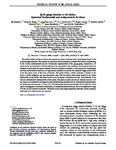Sp(4) gauge theories on the lattice: Quenched fundamental and antisymmetric fermions
| dc.contributor.author | Bennett, E | |
| dc.contributor.author | Hong, DK | |
| dc.contributor.author | Lee, J-W | |
| dc.contributor.author | Lin, C-JD | |
| dc.contributor.author | Lucini, B | |
| dc.contributor.author | Mesiti, M | |
| dc.contributor.author | Piai, M | |
| dc.contributor.author | Rantaharju, J | |
| dc.contributor.author | Vadacchino, Davide | |
| dc.date.accessioned | 2023-01-16T10:26:56Z | |
| dc.date.available | 2023-01-16T10:26:56Z | |
| dc.date.issued | 2020-04-01 | |
| dc.identifier.issn | 2470-0010 | |
| dc.identifier.issn | 2470-0029 | |
| dc.identifier.other | 074516 | |
| dc.identifier.uri | http://hdl.handle.net/10026.1/20169 | |
| dc.description.abstract |
We perform lattice studies of meson mass spectra and decay constants of the Sp(4) gauge theory in the quenched approximation. We consider two species of (Dirac) fermions as matter field content, transforming in the 2-index antisymmetric and the fundamental representation of the gauge group, respectively. All matter fields are formulated as Wilson fermions. We extrapolate to the continuum and massless limits and compare to each other the results obtained for the two species of mesons. In the case of two fundamental and three antisymmetric fermions, the long-distance dynamics is relevant for composite Higgs models. This is the first lattice study of this class of theories. The global SU(4)×SU(6) symmetry is broken to the Sp(4)×SO(6) subgroup, and the condensates align with the explicit mass terms present in the lattice formulation of the theory. The main results of our quenched calculations are that, with fermions in the 2-index antisymmetric representation of the group, the masses squared and decay constant squared of all the mesons we considered are larger than the corresponding quantities for the fundamental representation, by factors that vary between ∼1.2 and ∼2.7. We also present technical results that will be useful for future lattice investigations of dynamical simulations, of composite chimera baryons, and of the approach to large N in the Sp(2N) theories considered. We briefly discuss their high-temperature behavior, where symmetry restoration and enhancement are expected. | |
| dc.format.extent | 074516- | |
| dc.language | en | |
| dc.language.iso | en | |
| dc.publisher | American Physical Society (APS) | |
| dc.title | Sp(4) gauge theories on the lattice: Quenched fundamental and antisymmetric fermions | |
| dc.type | journal-article | |
| dc.type | Journal Article | |
| plymouth.issue | 7 | |
| plymouth.volume | 101 | |
| plymouth.publication-status | Published online | |
| plymouth.journal | Physical Review D | |
| dc.identifier.doi | 10.1103/physrevd.101.074516 | |
| plymouth.organisational-group | /Plymouth | |
| plymouth.organisational-group | /Plymouth/Faculty of Science and Engineering | |
| plymouth.organisational-group | /Plymouth/Faculty of Science and Engineering/School of Engineering, Computing and Mathematics | |
| plymouth.organisational-group | /Plymouth/Users by role | |
| plymouth.organisational-group | /Plymouth/Users by role/Academics | |
| dcterms.dateAccepted | 2020-04-03 | |
| dc.rights.embargodate | 2023-1-17 | |
| dc.identifier.eissn | 2470-0029 | |
| dc.rights.embargoperiod | Not known | |
| rioxxterms.versionofrecord | 10.1103/physrevd.101.074516 | |
| rioxxterms.licenseref.uri | http://www.rioxx.net/licenses/all-rights-reserved | |
| rioxxterms.type | Journal Article/Review |


